
by Ray Bodrey | Oct 14, 2021
Tree dieback is a complex syndrome and slow developing. Dieback is essentially a process in which trees lose leaves and limbs. This usually occurs as a result of severe stress to the tree’s bark or root system, but could be a result of a declining life cycle.
It’s important to note that there is a significant balance between a tree’s root system and the number of leaves and limbs it can support. For example, if a tree loses part of its root system, possibly due to disease or lawn equipment damage, the tree will forfeit a portion of its leaves. Dieback doesn’t happen overnight, though. It’s a slow process, with larger trees taking much longer time for signs of stress to emerge. However, a large tree root system is very sensitive to damage, whereas a small tree will adapt quickly and is much more resilient to damage. So, what can be done to prevent dieback in trees?
First and foremost, trees, like all living things, have a natural life cycle. Regardless of how you care for your trees, dieback will occur. The most important management measure in extending the life of a tree is to protect the root system and bark.
With each passing year, a tree grows new bark in the rejuvenation process. The bark replacement process inevitably becomes more difficult as the tree gets older and in turn the tree is more and more susceptible to dieback. If the bark becomes damaged, especially later in the tree’s life cycle, then fungi and insects have a much greater chance to cause serious harm. Treating bark damage with a wound dressing to prevent decay is the recommended procedure.
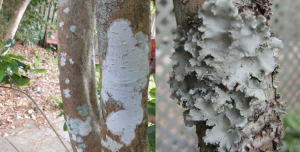
Lichens come in many forms and are commonly blamed for the decline and death of trees and shrubs, however they do not cause harm. Credit. Sydney Park Brown and Joseph Sewards, UF/IFAS.
A common misconception is that epiphytes, such as lichens and Spanish moss, are tree diseases. Epiphytes are known as “air plants” and thrive in the Panhandle. They survive on moisture and nutrients in the atmosphere and are harmless to trees. However, a tree that becomes inundated with epiphytes may be an indicator of excessive soil moisture, which may lead to root rot.
Lawn weed killers can have detrimental effects to trees, even if the application seems to be from a safe distance. When using a weed killer near a tree’s root system, confirm on the label that the product is designed to kill green growth only. It can’t be overstated that excessively fertilizing an old tree will greatly accelerate the decline of the tree. Some may think this will stimulate a tree and extend its life, but instead it will do the opposite. Young trees can tolerate fertilizer applications, as they need crown growth. Older trees will simply become top heavy, and structural damage will likely occur.
Don’t forget, trees need space too. A mature tree forced to occupy a small space will simply not adapt. Be sure to have adequate spacing when planting younger trees and shrubs in the vicinity of older trees. Also, keep your trees pruned away from touching structures and utilities.
Tree dieback is a complex issue to manage. By following these measures, you can help extend the life of your trees and continue to have a picturesque landscape.
For more information on tree dieback, contact your local county extension office.
Please visit Florida Friendly Landscaping, http://fyn.ifas.ufl.edu/, for more information on maintaining your landscape.
For more general information on lichens, please see UF/IFAS EDIS document “Spanish Moss, Ball Moss and Lichens-Harmless Epiphytes” by Joe Sewards and Dr. Sydney Park Brown: https://edis.ifas.ufl.edu/pdffiles/EP/EP48500.pdf
UF/IFAS Extension is an Equal Opportunity Institution.
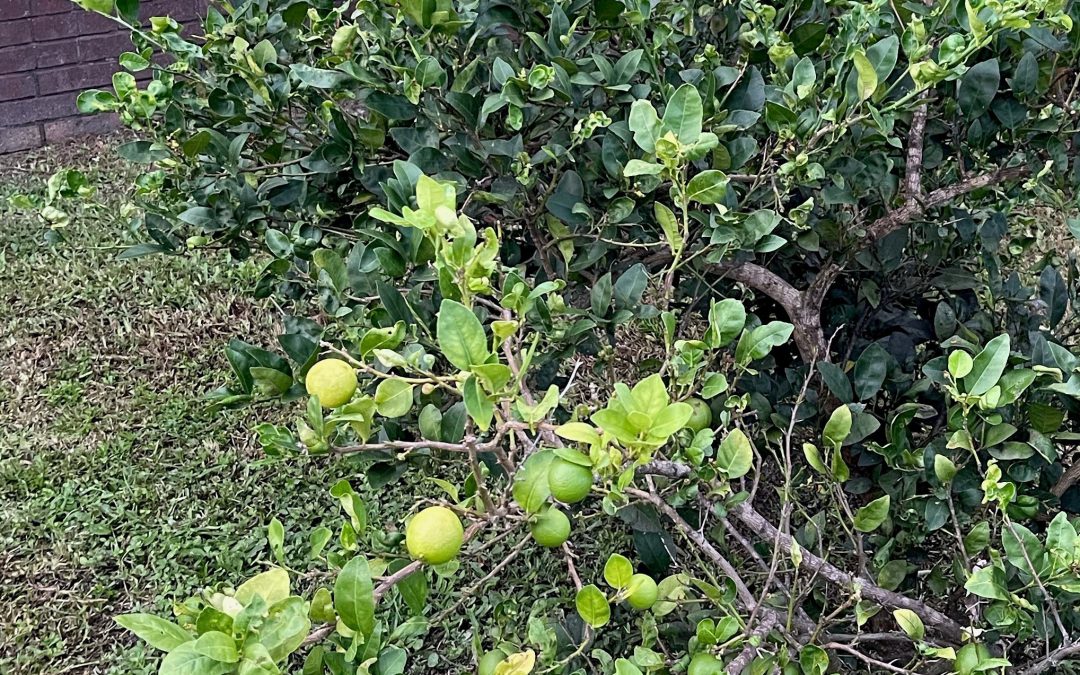
by Ray Bodrey | Sep 9, 2021
Growing Key Limes in the home landscape is not only a fun and unique addition, but is also delicious – any way you slice them.
The key lime, Citrus aurantifolia, originated in southeast Asia. Genetically speaking, the key lime is likely a tri-hybrid cross between the “odd ball fruits”, known as citron, pummelo and a microcitrus species, Citrus micrantha. There is little commercial key lime production nowadays in Florida, but the fruit remains a very popular landscape option.
The key lime is a small, bushy tree that makes harvest and pruning a breeze. Like most citrus, it’s self-pollinating. The key lime is also an ever-bearing fruit, so there is no real seasonal harvest. The tree could technically bloom any month of the year. There are very few varieties, as trees mostly come from true seed or air layering.
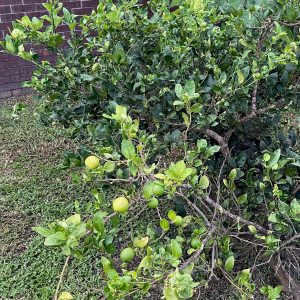
Key Lime fruit at various degrees of ripeness. Photo courtesy of Ray Bodrey, UF/IFAS Extension Gulf County.
Climate is an important factor when deciding to plant a key lime. They are sensitive to cold temperatures, especially below freezing. For the Panhandle, it’s wise to keep key lime trees as patio citrus. In other words, keep the trees in pots so that they can be moved indoors for protection during the winter months. In the ground, trees should be planted in an area where there is a significant wind block. Once a few years have passed and tree has become more mature and acclimated to the environment, they may be able to survive on their own, though it is recommended to cover the tree under sub-freezing temperatures. However, it is important to remember that sunlight is a catalyst for citrus fruit production, be sure to plant the tree in an area with full sun.
The usual suspects of citrus insect pests apply to the key lime also. Citrus leaf miner and mites are the most common culprits. Horticultural and insecticidal oils will certainly help to combat these threats. For planting, key lime is well adapted to a variety of soil conditions in Florida. Be sure to water newly planted trees every other day for the first week and then one to two times a week for the first couple of months. Water periodically after that, making sure the soil doesn’t stay completely dry for long periods. A 6-6-6 fertilizer works great for the key lime. Please follow the fertilizer schedule found in the UF/IFAS EDIS publication, “Citrus Culture in the Home Landscape” by Robert E. Rouse and Mongi Zekri: https://edis.ifas.ufl.edu/pdf/HS/HS132/HS132-11822781.pdf
A final interesting thing about the key lime is the ripening stages of the fruit. Because key limes are ever-bearers, blooms can develop at sometimes widely varying times. This causes an uneven development of fruit across the tree. Be sure to wait until the fruit turns begins to turn yellow before harvest. That’s when it’s mature to eat! Fruit can be stored for up to a week in the fridge or can be juiced and stored in the freezer for later use.
Please contact your local county Extension office for more information. Happy Gardening!
Information for this article can be found in the UF/IFAS EDIS publication, “Key Lime Growing in the Florida Home Landscape” by Jonathan H. Crane: https://edis.ifas.ufl.edu/publication/CH092
UF/IFAS Extension is an Equal Opportunity Institution.
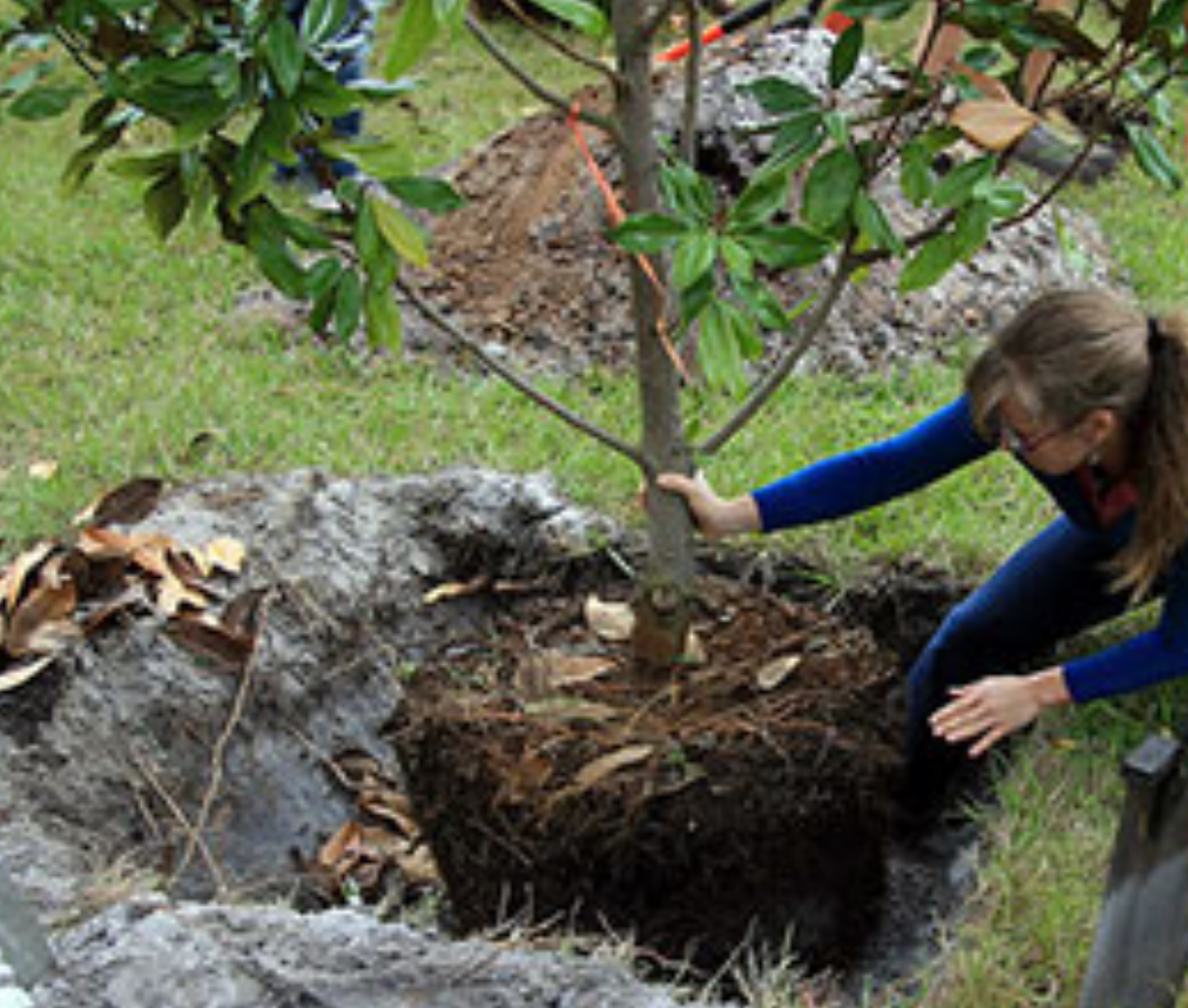
by Ray Bodrey | Jul 29, 2021
Need tips on planting and caring for trees? The primary focus in care of your newly planted tree is root development. It takes several months for roots to establish and newly planted trees and shrubs do not have a very strong root system. Start by digging the hole in a popcorn bowl shape. Once planted, backfill around the root system, but be careful not to compact the soil as this will hinder root growth. Be sure to keep the topmost area of the root ball exposed, about one to two inches. A layer of mulch will be applied here.
Frequent watering is much needed, especially if you are planting in the summer. Water thoroughly, so that water percolates below the root system. Shallow watering promotes surface root growth, which will make the plant more susceptible to stress during a drought. Concentrate some of the water in a diameter pattern a few feet from the trunk. This will cause the root system to grow towards the water, and thus better establish the root system and anchor the tree.
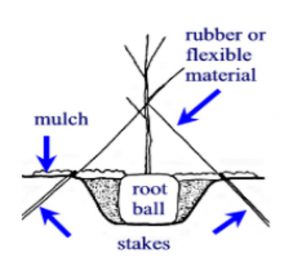
Figure: A Traditional Staking Option. Credit: Edward F. Gilman, UF/IFAS Extension.
Mulch is important in the conservation of soil moisture. Pine needles, bark, wood chips, and other organic materials make a great mulch. A three inch layer of mulch will usually suffice. It’s important to keep the mulch a few inches from the trunk as mulching too close to the tree trunk can cause rot.
You should always prune the bare roots of trees during planting. These exposed roots in containers can be damaged in shipping and removing some of the roots will help trigger growth. Pruning some of the top foliage can also reduce the amount of water needed for the plant to establish, as well. Trees and shrubs grown and shipped in burlap or containers usually need very little pruning.
Newly planted trees often have a difficult time establishing if the root system cannot be held in place. Strong winds and rain can cause the plant to tip over. Avoid this by staking the plant for temporary support. A good rule of thumb to determine staking need is if the trunk diameter measures three inches or less, it probably needs some support! Tie the stake to the plant every six inches from the top. However, only tie the trunk at one spot. Don’t tie too tightly so that the tree has no flexibility. This will stunt the growth of the tree.
Following these tips will help ensure your tree becomes well established in your landscape. For more information please contact your local county extension office.
Information for this article can be found in the UF/IFAS EDIS publication: “Planting and Establishing Trees” by Edward F. Gilman and Laura Sadowiski: https://edis.ifas.ufl.edu/pdf%5CEP%5CEP31400.pdf
Supporting information also provided by UF/IFAS Extension Forestry Specialist Dr. Patrick Minogue, of the North Florida Research Education Center in Quincy, Florida.
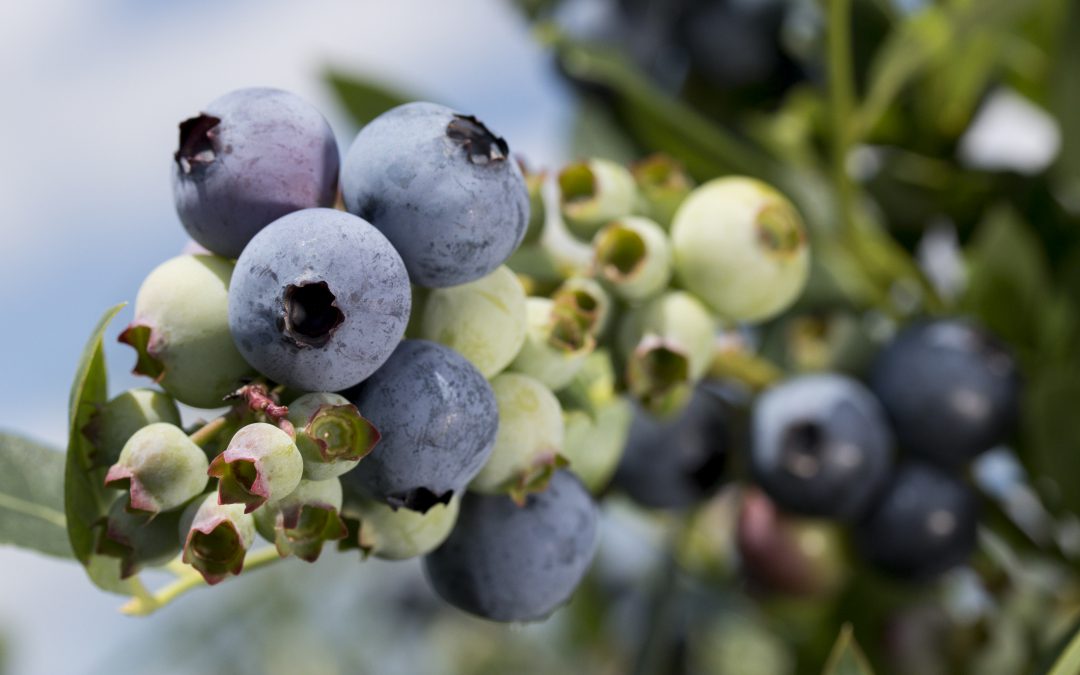
by Ray Bodrey | Jun 24, 2021
We have many choices of fruit that can be grown in the Florida Panhandle. For us hobby or dooryard growers, fruit trees can be an interesting crop to manage and most find it to be a beautiful addition to home landscapes. However, temperature and variety selection are key.
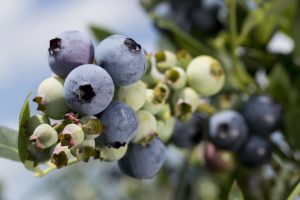
Blueberry Crop at UF/IFAS Plant Science Research & Education Unit. Photo Credit: Tyler Jones, UF/IFAS
Most fruit trees grown in the Panhandle are more temperate varieties, rather than tropical and subtropical fruits. Depending on the variety, winters in northern Florida may be too cold or may be too long for some fruit trees. Cold hardiness is a term used on fruit tree labels and reference guides. This refers to the plant’s ability to survive cooler or even freezing temperatures. In contrast, summer heat can also play a role in survivability. Some varieties are intolerant to excessive heat and humidity. The U.S. Department of Agriculture has developed a Plant Hardiness Zone Map that is helpful in selecting a variety of fruit tree: http://planthardiness.ars.usda.gov/PHZMWeb/. This is a standard by which gardeners and growers can determine which plants will thrive in their location. Northern Gulf County is in Zone 8b (15 to 20 degrees F), while coastal Gulf is in Zone 9a (20 to 25 degrees F).
Chilling requirement is another important topic when deciding on variety. Temperate zone fruit go through a “rest period” during the dormant months. For these fruit trees, a minimum length of time of cooler weather is needed for proper flowering to occur once favorable temperatures arrive. This rest period is essentially a reset. For the Panhandle, temperatures below 45 degrees F are known as chilling temperatures. The number of hours during the fall and winter that reach below this temperature equals the total chilling hours. For the Panhandle, this is rarely fewer than 500 hours. A plant that does not receive ample chilling will most likely be slow in bud and leaf development. Leaf expansion will be in increments throughout the year instead of in one period. On the other hand, colder, longer winters can cause fruit trees to end the rest stage early and begin to bud as soon as warmer temperatures arrive. This circumstance can cause cold injury later, as the Panhandle is historically known for late cold spells.
Citrus is a dooryard fruit, however it’s a subtropical fruit tree and not technically temperate. However, there are some varieties that thrive in the Panhandle. Another key to growing citrus, is to select varieties with different fruit maturity seasons. This way you can enjoy citrus year-round.
Some examples of dooryard fruit trees and varieties that are suitable for northern Florida are:
Apple: ‘TropicSweet’, ‘Anna’, ‘Dorsett Golden’
Blueberry: ‘Rabbiteye’, ‘Climax’, ‘Highbush’
Grapefruit: ‘Marsh’, ‘Ruby Red’
Lemon: ‘Myer’
Nectarine: ‘Suncoast’
Orange/Mandarin: ‘Navel’, ‘Parson Brown’, ‘Valencia’, Satsuma
Peach: ‘Gulfcrest’, ‘Gulfking’, ‘Gulfprince’
Pear: ‘Ayers’, ‘Baldwin’, ‘Kieffer’
Pecan: ‘Elliot’, ‘Stuart’, ‘Moreland’
So, where do I find information on varieties? The UF web publication “Dooryard Fruit Varieties” is a great resource. Also contact your local county extension office for more information.
Information for this article can be found in the UF/IFAS EDIS publication: “Dooryard Fruit Varieties” by J. G. Williamson, J. H. Crane, R. E. Rouse, and M. A. Olmstead: http://edis.ifas.ufl.edu/pdffiles/MG/MG24800.pdf
UF/IFAS Extension is an Equal Opportunity Institution.
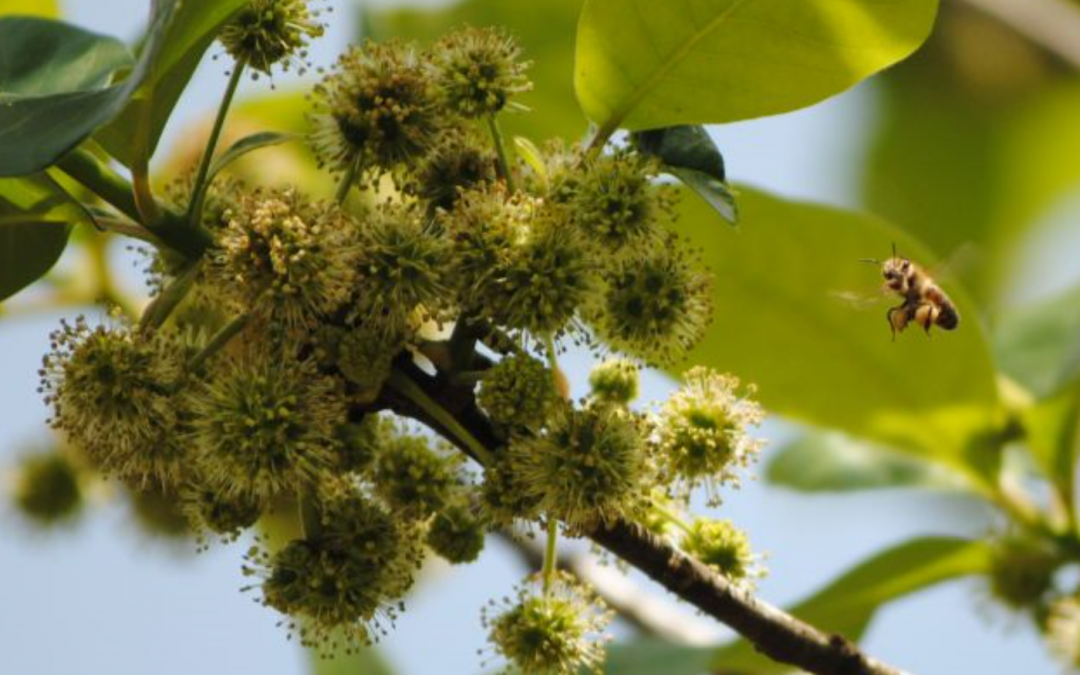
by Ray Bodrey | May 6, 2021
The Annual Tupelo Honey Festival will be held Saturday, May 15th from 9 am – 4 pm central time at Lake Alice Park in Wewahitchka. This is your chance to take part in a local treat. Area honey producers will be on hand to sell their honey in a variety of sizes. There will also be food, art and crafts, and live music.
For decades, tupelo honey has been synonymous with Gulf county. The nectar from the tupelo gum tree (Nyssa ogeche), produces some of the finest honey in the world. The common name “tupelo” is derived from language of the Muscogee Nation, also known as the Creek Indian Nation. The meaning of the word is “swamp tree”, as this tree flourishes in areas of wet soils and seasonal flooding. Gulf County is home to one of the largest tupelo forests on earth.
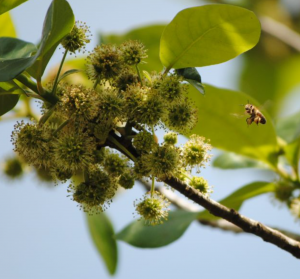
A honeybee visiting tupelo blossoms. Photo Credit: Gulf County Tourist Development Council.
The tupelo bloom season lasts from approximately mid-April to the end of May. This is an anxious time for beekeepers. Tupelo blooms are very temperamental and delicate in nature. For this short period, beekeepers hope for little wind or rain and no cold temperatures, as any of these factors can make or break tupelo honey production. Regardless of seasonal impacts, the demand for Gulf County’s tupelo honey never subsides.
Please visit http://www.tupelohoneyfestival.com/ for more information on the festival. For more information on beekeeping, contact your local county extension office.
UF/IFAS Extension is an Equal Opportunity Institution.










